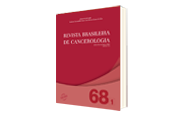Cytoreductive Surgery with Hyperthermic Intraperitoneal Chemotherapy in Patients with Appendix Mucinous Adenocarcinoma: Series of 43 Cases
DOI:
https://doi.org/10.32635/2176-9745.RBC.2022v68n1.1696Keywords:
hyperthermic intraperitoneal chemotherapy, appendiceal neoplasms, cytoreduction surgical proceduresAbstract
Introduction: Primary appendix carcinoma is a rare condition. Many international retrospective reviews outline the experience of different centers in appendicular neoplasms. The cancer treatment in this location is complex and depends on the histological subtype and the extent of the disease. One of the most promising treatments is cytoreductive surgery (CRS) and hyperthermic intraperitoneal chemotherapy (HIPEC). In Brazil, there is no description of series of cases with this therapeutic approach. The purpose of this case series is to analyze the sociodemographic characteristics and the type of therapeutic intervention in patients with malignant diseases of the appendix in a High Complexity Care Center in Oncology III (Cacon III). Case reports: 43 cases of primary appendix tumors were included. Low-grade mucinous adenocarcinoma was the most diagnosed neoplasm. The main protocol used was 1 to 2 surgeries and application of mitomycin C at an average temperature of 40 degrees. There was great heterogeneity regarding the use of the protocol. Conclusion: The present report of 43 cases is important because it is a rare tumor with this location. The therapeutic modality described is promising, but there is no defined protocol for this purpose. It is necessary to update the therapeutic guidelines to standardize the conduct internally, especially in the case of a national reference unit.
Downloads
References
Van de Moortele M, De Hertogh G, Sagaert X, et al. Appendiceal cancer: a review of the literature. Acta Gastroenterol Belg. 2020;83(3):441-8. Cited in: PubMed; PMID 33094592.
Turaga KK, Pappas SG, Gamblin TC. Importance of histologic subtype in the staging of appendiceal tumors. Ann Surg Oncol. 2012;19(5):1379-85. doi: https://doi.org/10.1245/s10434-012-2238-1
Morris MC, Dhar VK, Stevenson MA, et al. Adjuvant hyperthermic intraperitoneal chemotherapy (HIPEC) for patients at high-risk of peritoneal metastases. Surg Oncol. 2019;31:33-7. doi: https://doi.org/10.1016/j.suronc.2019.09.002
Subramanya D, Grivas PD, Styler M. Appendiceal carcinoma: a diagnostic and therapeutic challenge. Postgrad Med. 2008;120(4):95-100. doi: https://doi.org/10.3810/pgm.2008.11.1944
Bijelic L, Kumar AS, Stuart OA, et al. Systemic chemotherapy prior to cytoreductive surgery and HIPEC for carcinomatosis from appendix cancer: impact on perioperative outcomes and short-term survival. Gastroenterol Res Pract. 2012;2012:163284. doi: https://doi.org/10.1155/2012/163284
Solanki SL, Mukherjee S, Agarwal V, et al. Society of Onco-Anaesthesia and Perioperative Care consensus guidelines for perioperative management of patients for cytoreductive surgery and hyperthermic intraperitoneal chemotherapy (CRS-HIPEC). Indian J Anaesth. 2019;63(12):972-87. doi: https://doi.org/10.4103/ija.IJA_765_19
Graziosi L, Marino E, De Angelis V, et al. Survival prognostic factors in patients undergoing cytoreductive surgery and hyperthermic intraperitoneal chemotherapy treatment: analysis from a single oncological center. World J Surg Oncol. 2016;14:97. doi: https://doi.org/10.1186/s12957-016-0856-y
Kemmel V, Mercoli HA, Meyer N, et al. Mitomycin C pharmacokinetics as predictor of severe neutropenia in hyperthermic intraperitoneal therapy. Ann Surg Oncol. 2015;22:873-9. doi: https://doi.org/10.1245/s10434-015-4679-9
Moaven O, Votanopoulos KI, Shen P. Health-related quality of life after cytoreductive surgery/HIPEC for mucinous appendiceal cancer: results of a multicenter randomized trial comparing oxaliplatin and mitomycin. Ann Surg Oncol. 2020;27(3):772-80. doi: https://doi.org/10.1245/s10434-019-08064-6
Schaaf L, van der Kuip H, Zopf W, et al. A temperature of 40ºC appears to be a critical threshold for potentiating cytotoxic chemotherapy in vitro and in peritoneal carcinomatosis patients undergoing HIPEC. Ann Surg Oncol. 2015;22:758-65. doi: https://doi.org/10.1245/s10434-015-4853-0
Leiting JL, Day CN, Harmsen WS, et al. The impact of HIPEC vs. EPIC for the treatment of mucinous appendiceal carcinoma: a study from the US HIPEC collaborative. Int J Hyperthermia. 2020;37(1):1182-8. doi: https://doi.org/10.1080/02656736.2020.1819571
Published
How to Cite
Issue
Section
License
Os direitos morais e intelectuais dos artigos pertencem aos respectivos autores, que concedem à RBC o direito de publicação.

This work is licensed under a Creative Commons Attribution 4.0 International License.









